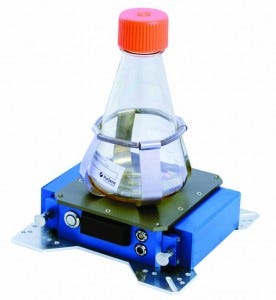Ask the Expert: Accelerating Bioprocess Development Using Shake-Flask Metabolic Activity Data
December 11, 2014
with Dr. Gernot John of PreSens Precision Sensing GmbH
Shake flasks are simple, low-cost devices widely used in screening and media optimization. The most widely measured parameter to determine biomass is optical density (OD). It is typically measured offline because no suitable equipment for broad range biomass measurements in shake flasks has been available. But a new, compact, SFR vario device from PreSens Precision Sensing can be placed under shake flasks to measure four parameters online: pH, O2 saturation, oxygen use rate (OUR), and biomass.

John’s Presentation
Our goal is to make shake-flasks give you more information to improve your process understanding. Oxygen (O2) and pH sensing dots are integrated into shake-flasks, and their fluorescent signals are read by our device to determine oxygen and pH online. Integrated into the system’s optics, our biomass sensor measures light scattering. During movement of shake flasks, liquid distribution is uneven and adjusted toward one side of the shake- flask. Measuring at the right time is important, so we integrated an additional sensor that measures shaker position to ensure correct measurements depending on rotation frequency.
A complete system can be integrated into most incubators. It includes wireless data transmission and two rechargeable batteries. Modular software measures up to four devices in parallel, with visualization of current measurements. It can compare current and stored data to show deviations.
Application Examples: One interesting application is for monitoring metabolic shifts. Gaps in the graphs are caused by stopping the shaker to take samples for offline glucose and lactose measurements. That influences the oxygen parameter because any disturbance changes the oxygen ingress and thus the media’s O2 concentration. Offline measurement disturbs a cultivation.
O2 concentration increases when glucose goes into limitation, when pH stops decreasing. Looking at scattered light, we see little bands that indicate a slow-down or even cessation of growth. After depletion of glucose, a system must adapt to metabolize a new substrate, thus undergoing a metabolic shift that is clearly indicated by our biomass and oxygen sensors. Even without offline measurements, the metabolic shift is clearly shown.
Yeast growth measurement is another interesting application. With online biomass, pH, and dissolved oxygen (DO) measurement (and offline measurement of glucose), we cultivated a yeast that is used commercially to produce lactase enzyme. We could clearly distinguish two different growth phases with glucose as a primary substrate: In the first phase, glucose is metabolized under aerobic conditions, and the O2 content decreases continuously to very low levels (<5% saturation) due to rising oxygen uptake during high metabolic activity. Also, pH decreases from 7 to about 6. The biomass goes through a distinct change at that point, indicating a metabolic shift that is easily shown without offline information.
Both examples show how the SFR vario system can be applied to determine metabolic changes without critical offline sampling.
Questions and Answers
Which flasks can be used with this device? The device is prepared for 125-mL to 2-L flasks, either baffled or nonbaffled flasks.
What is the recommended minimum volume for accurate DO reading? The integrated sensors work with very low volumes — depending on medium viscosity and cultivation type.
Do you have mammalian-culture examples? Mammalian cultures are typically less absorbant than microbial samples. This complicates scattered light measurements, so we can only measure at high cell concentrations.
Does the system work with photosynthetic organisms? Because the measurement principle uses modulated light, the system can work under different light conditions. The important factor is the culture’s density. We need a minimum density for a scattered-light signal.
Is it possible to use colored glass? It depends on the color. Brown like a beer bottle would be difficult. But a yellowish flask would be possible with some calibration adjustment.
Are these sensors single-use or multiuse? Actually we have both. Multiuse glass flasks with integrated oxygen sensors need to be calibrated by users. We also have precalibrated, disposable sensors with integrated oxygen and pH measurement. The biomass measurement works with both glass or plastic flasks. In some shake-flask cultures, cells stick to the upper layer of the media on the flask wall.
How would you prevent that? I think that is due to the surface characteristics of the flask. So I would probably try to change the flask material, maybe from plastic to glass or vice versa.
More Online
The full presentation of this “Ask the Expert” webcast — with data — can be found on the BioProcess International website at http://bit.ly/ATE-1014.
You May Also Like





